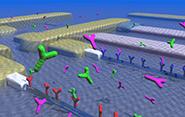Tiny sensors, huge potential

Imagine a swarm of tiny devices only a few hundred nanometers in size that can detect trace amounts of toxins in a water supply or the very earliest signs of cancer in the blood. Now imagine that these tiny sensors can reset themselves, allowing for repeated use over time inside a body of water – or a human body.
Improving nanodevice biosensors is the goal of Mark Reed, Harold Hodgkinson Professor of Electrical Engineering at the Yale School of Engineering & Applied Science. Reed and his colleagues have reported a recent breakthrough in designing electronic biosensors that can be regenerated and reused repeatedly.
Biosensors are used to detect and measure toxins in the environment; in the body they can identify chemical biomarkers that signal cancer and disease states by detecting changes at the molecular level. Reed’s lab has created biosensors using silicon nanowires configured as tiny transistors that are exponentially more sensitive than current sensing technology, in addition to being cheaper and easier to use.
Reed’s latest research, published in the journal ACS Nano, outlines a method to add a layer of molecules to the surface of the biosensor that can be chemically regenerated, allowing for reuse. The ability to recharge nanodevice biosensors makes them more useful for applications like the remote monitoring of toxins or biothreats.
Co-authors on the paper are Xuexin Duan, Nitin K. Rajan, David A. Routenberg and Jurriaan Huskens.
In addition to pollution and toxin detection, nanodevice biosensor technology has the potential to transform health care, enabling the diagnosis of diseases long before they can be detected by current methods and allowing for much earlier intervention and treatment.
“The conventional wisdom was that these sensors could not be reused and it’s been one of the grand challenges of the field,” Reed said. “This discovery is exciting in that this technology has the potential to make real improvements in applications like cancer diagnosis, drug screening and pollution detection.”

